A Metabolomic Study of the Variability of the Chemical Composition of Commonly Consumed Coffee Brews
Abstract
1. Introduction
2. Results
2.1. Untargeted Constituent Profiles and Variation Due to Different Coffee Parameters
2.2. Annotation of Coffee Compounds in Coffee Brew Metabolomic Data
2.3. Association of Coffee Compound Profiles with Different Types of Coffee Brews
2.4. Coffee Compounds Associated with Coffee Brew Characteristics
3. Discussion
4. Materials and Methods
4.1. Standards and Reagents
4.2. Purchase and Brew of Coffee Samples
4.3. Untargeted Chemical Profiling of Coffee Samples Using Liquid Chromatography-Mass Spectrometry
4.4. Mining of Untargeted Metabolomic Data for Known Coffee Compounds
4.5. Statistical Analysis
5. Conclusions
Supplementary Materials
Author Contributions
Funding
Conflicts of Interest
Abbreviations
References
- Loftfield, E.; Freedman, N.D.; Graubard, B.I.; Guertin, K.A.; Black, A.; Huang, W.-Y.; Shebl, F.M.; Mayne, S.T.; Sinha, R. Association of Coffee Consumption With Overall and Cause-Specific Mortality in a Large US Prospective Cohort Study. Am. J. Epidemiol. 2015, 182, 1010–1022. [Google Scholar] [CrossRef] [PubMed]
- Je, Y.; Giovannucci, E. Coffee consumption and total mortality: A meta-analysis of twenty prospective cohort studies. Br. J. Nutr. 2014, 111, 1162–1173. [Google Scholar] [CrossRef]
- Gunter, M.J.; Murphy, N.; Cross, A.J.; Dossus, L.; Dartois, L.; Fagherazzi, G.; Kaaks, R.; Kuhn, T.; Boeing, H.; Aleksandrova, K.; et al. Coffee Drinking and Mortality in 10 European Countries: A Multinational Cohort Study. Ann. Intern. Med. 2017, 167, 236–247. [Google Scholar] [CrossRef] [PubMed]
- Park, S.Y.; Freedman, N.D.; Haiman, C.A.; Le Marchand, L.; Wilkens, L.R.; Setiawan, V.W. Association of Coffee Consumption With Total and Cause-Specific Mortality Among Nonwhite Populations. Ann. Intern. Med. 2017, 167, 228–235. [Google Scholar] [CrossRef] [PubMed]
- Van Dam, R.M.; Hu, F.B. Coffee consumption and risk of type 2 diabetes—A systematic review. JAMA 2005, 294, 97–104. [Google Scholar] [CrossRef] [PubMed]
- Grosso, G.; Micek, A.; Godos, J.; Sciacca, S.; Pajak, A.; Martinez-Gonzalez, M.A.; Giovannucci, E.L.; Galvano, F. Coffee consumption and risk of all-cause, cardiovascular, and cancer mortality in smokers and non-smokers: A dose-response meta-analysis. Eur. J. Epidemiol. 2016, 31, 1191–1205. [Google Scholar] [CrossRef] [PubMed]
- Sang, L.X.; Chang, B.; Li, X.H.; Jiang, M. Consumption of coffee associated with reduced risk of liver cancer: A meta-analysis. BMC Gastroenterol. 2013, 13, 34. [Google Scholar] [CrossRef]
- Lai, G.Y.; Weinstein, S.J.; Albanes, D.; Taylor, P.R.; McGlynn, K.A.; Virtamo, J.; Sinha, R.; Freedman, N.D. The association of coffee intake with liver cancer incidence and chronic liver disease mortality in male smokers. Br. J. Cancer 2013, 109, 1344–1351. [Google Scholar] [CrossRef]
- Zhou, Q.; Luo, M.-L.; Li, H.; Li, M.; Zhou, J.-G. Coffee consumption and risk of endometrial cancer: A dose-response meta-analysis of prospective cohort studies. Sci. Rep. 2015, 5, 13410. [Google Scholar] [CrossRef]
- Gunter, M.J.; Schaub, J.A.; Xue, X.N.; Freedman, N.D.; Gaudet, M.M.; Rohan, T.E.; Hollenbeck, A.R.; Sinha, R. A prospective investigation of coffee drinking and endometrial cancer incidence. Int. J. Cancer 2012, 131, E530–E536. [Google Scholar] [CrossRef]
- Poole, R.; Kennedy, O.J.; Roderick, P.; Fallowfield, J.A.; Hayes, P.C.; Parkes, J. Coffee consumption and health: Umbrella review of meta-analyses of multiple health outcomes. BMJ 2017, 359, j5024. [Google Scholar] [CrossRef] [PubMed]
- Caprioli, G.; Cortese, M.; Sagratini, G.; Vittori, S. The influence of different types of preparation (espresso and brew) on coffee aroma and main bioactive constituents. Int. J. Food Sci. Nutr. 2015, 66, 505–513. [Google Scholar] [CrossRef] [PubMed]
- Niseteo, T.; Komes, D.; Belscak-Cvitanovic, A.; Horzic, D.; Budec, M. Bioactive composition and antioxidant potential of different commonly consumed coffee brews affected by their preparation technique and milk addition. Food Chem. 2012, 134, 1870–1877. [Google Scholar] [CrossRef] [PubMed]
- Ciaramelli, C.; Palmioli, A.; Airoldi, C. Coffee variety, origin and extraction procedure: Implications for coffee beneficial effects on human health. Food Chem. 2019, 278, 47–55. [Google Scholar] [CrossRef] [PubMed]
- Rothwell, J.A.; Fillâtre, Y.; Martin, J.-F.; Lyan, B.; Pujos-Guillot, E.; Fezeu, L.; Hercberg, S.; Comte, B.; Galan, P.; Touvier, M.; et al. New Biomarkers of Coffee Consumption Identified by the Non-Targeted Metabolomic Profiling of Cohort Study Subjects. PLoS ONE 2014, 9, e93474. [Google Scholar] [CrossRef] [PubMed]
- Edmands, W.M.; Ferrari, P.; Rothwell, J.A.; Rinaldi, S.; Slimani, N.; Barupal, D.K.; Biessy, C.; Jenab, M.; Clavel-Chapelon, F.; Fagherazzi, G.; et al. Polyphenol metabolome in human urine and its association with intake of polyphenol-rich foods across European countries. Am. J. Clin. Nutr. 2015, 102, 905–913. [Google Scholar] [CrossRef] [PubMed]
- Rothwell, J.A.; Keski-Rahkonen, P.; Robinot, N.; Assi, N.; Casagrande, C.; Jenab, M.; Ferrari, P.; Boutron-Ruault, M.C.; Mahamat-Saleh, Y.; Mancini, F.R.; et al. A metabolomic study of biomarkers of habitual coffee intake in four European countries. Mol. Nutr. Food Res. 2019. Submitted. [Google Scholar]
- Alves, R.C.; Casal, S.; Oliveira, M.B.P.P. Tocopherols in coffee brews: Influence of coffee species, roast degree and brewing procedure. J. Food Comp. Anal. 2010, 23, 802–808. [Google Scholar] [CrossRef]
- Becalski, A.; Halldorson, T.; Hayward, S.; Roscoe, V. Furan, 2-methylfuran and 3-methylfuran in coffee on the Canadian market. J. Food Comp. Anal. 2016, 47, 113–119. [Google Scholar] [CrossRef]
- Fujioka, K.; Shibamoto, T. Chlorogenic acid and caffeine contents in various commercial brewed coffees. Food Chem. 2008, 106, 217–221. [Google Scholar] [CrossRef]
- Marcucci, C.T.; Benassi, M.d.T.; Almeida, M.B.; Nixdorf, S.L. Trigonelline, 5-caffeoylquinic acid, cafeine and melanoidins levels in commercial Brazilian instant coffees (portuguese). Química Nova 2013, 36, 544–548. [Google Scholar] [CrossRef]
- Clifford, M.N. Chlorogenic acids and other cinnamates—Nature, occurence and dietary burden. J. Sci. Food. Agric. 1999, 79, 362–372. [Google Scholar] [CrossRef]
- Schymanski, E.L.; Jeon, J.; Gulde, R.; Fenner, K.; Ruff, M.; Singer, H.P.; Hollender, J. Identifying Small Molecules via High Resolution Mass Spectrometry: Communicating Confidence. Environ. Sci. Technol. 2014, 48, 2097–2098. [Google Scholar] [CrossRef] [PubMed]
- Ludwig, I.A.; Clifford, M.N.; Lean, M.E.J.; Ashihara, H.; Crozier, A. Coffee: Biochemistry and potential impact on health. Food Funct. 2014, 5, 1695–1717. [Google Scholar] [CrossRef] [PubMed]
- Ginz, M.; Engelhardt, U.H. Identification of Proline-Based Diketopiperazines in Roasted Coffee. J. Agric. Food Chem. 2000, 48, 3528–3532. [Google Scholar] [CrossRef]
- Ginz, M.; Engelhardt, U.H. Identification of new diketopiperazines in roasted coffee. Eur. Food Res. Technol. 2001, 213, 8–11. [Google Scholar] [CrossRef]
- Lang, R.; Yagar, E.F.; Wahl, A.; Beusch, A.; Dunkel, A.; Dieminger, N.; Eggers, R.; Bytof, G.; Stiebitz, H.; Lantz, I.; et al. Quantitative studies on roast kinetics for bioactives in coffee. J. Agric. Food Chem. 2013, 61, 12123–12128. [Google Scholar] [CrossRef]
- Okada, H.; Murata, M.; Ohyazu, K.; Homma, S. Distinction between Arabica and Robusta Coffee Beans by Hydroxycinnamic Acid Derivatives, Especially by p-Coumaroyltryptophan. Food Sci. Technol. Int. Tokyo 1997, 3, 205–209. [Google Scholar] [CrossRef]
- Garrett, R.; Vaz, B.G.; Hovell, A.M.C.; Eberlin, M.N.; Rezende, C.M. Arabica and Robusta Coffees: Identification of Major Polar Compounds and Quantification of Blends by Direct-Infusion Electrospray Ionization-Mass Spectrometry. J. Agric. Food Chem. 2012, 60, 4253–4258. [Google Scholar] [CrossRef]
- Ashihara, H. Metabolism of alkaloids in coffee plants. Braz. J. Plant Physiol. 2006, 18, 1–8. [Google Scholar] [CrossRef]
- Palmioli, A.; Ciaramelli, C.; Tisi, R.; Spinelli, M.; De Sanctis, G.; Sacco, E.; Airoldi, C. Natural Compounds in Cancer Prevention: Effects of Coffee Extracts and Their Main Polyphenolic Component, 5-O-Caffeoylquinic Acid, on Oncogenic Ras Proteins. Chem. Asian J. 2017, 12, 2457–2466. [Google Scholar] [CrossRef] [PubMed]
- Liang, N.; Kitts, D.D. Role of Chlorogenic Acids in Controlling Oxidative and Inflammatory Stress Conditions. Nutrients 2015, 8, 16. [Google Scholar] [CrossRef] [PubMed]
- Heckman, M.A.; Weil, J.; Gonzalez de Mejia, E. Caffeine (1,3,7-trimethylxanthine) in foods: A comprehensive review on consumption, functionality, safety, and regulatory matters. J. Food Sci. 2010, 75, R77–R87. [Google Scholar] [CrossRef] [PubMed]
- Kotyczka, C.; Boettler, U.; Lang, R.; Stiebitz, H.; Bytof, G.; Lantz, I.; Hofmann, T.; Marko, D.; Somoza, V. Dark roast coffee is more effective than light roast coffee in reducing body weight, and in restoring red blood cell vitamin E and glutathione concentrations in healthy volunteers. Mol. Nutr. Food Res. 2011, 55, 1582–1586. [Google Scholar] [CrossRef] [PubMed]
- Guertin, K.A.; Loftfield, E.; Boca, S.M.; Sampson, J.N.; Moore, S.C.; Xiao, Q.; Huang, W.-Y.; Xiong, X.; Freedman, N.D.; Cross, A.J.; et al. Serum biomarkers of habitual coffee consumption may provide insight into the mechanism underlying the association between coffee consumption and colorectal cancer. Am. J. Clin. Nutr. 2015, 101, 1000–1011. [Google Scholar] [CrossRef] [PubMed]
- Rothwell, J.; Madrid-Gambin, F.; Garcia-Aloy, M.; Gao, Q.; Andres-Lacueva, C.; Logue, C.; Gallagher, A.M.; Mack, C.; Kulling, S.; Dragsted, L.; et al. Biomarkers of intake for coffee, tea and sweetened beverages. Genes Nutr. 2018, 13, 15. [Google Scholar] [CrossRef] [PubMed]
- Midttun, Ø.; Ulvik, A.; Nygård, O.; Ueland, P.M. Performance of plasma trigonelline as a marker of coffee consumption in an epidemiologic setting. Am. J. Clin. Nutr. 2018, 107, 941–947. [Google Scholar] [CrossRef] [PubMed]
- Wishart, D.S.; Feunang, Y.D.; Marcu, A.; Guo, A.C.; Liang, K.; Vázquez-Fresno, R.; Sajed, T.; Johnson, D.; Li, C.; Karu, N.; et al. HMDB 4.0: The human metabolome database for 2018. Nucl. Acids Res. 2017. [Google Scholar] [CrossRef]
- Tautenhahn, R.; Böttcher, C.; Neumann, S. Annotation of LC/ESI-MS Mass Signals. Lect. Notes Comput. Sci. 2007, 4414, 371–380. [Google Scholar]
- Fages, A.; Ferrari, P.; Monni, S.; Dossus, L.; Floegel, A.; Mode, N.; Johansson, M.; Travis, R.; Bamia, C.; Sánchez-Pérez, M.-J.; et al. Investigating sources of variability in metabolomic data in the EPIC study: The Principal Component Partial R-square (PC-PR2) method. Metabolomics 2014, 10, 1074–1083. [Google Scholar] [CrossRef]
- Warrack, B.M.; Hnatyshyn, S.; Ott, K.H.; Reily, M.D.; Sanders, M.; Zhang, H.Y.; Drexler, D.M. Normalization strategies for metabonomic analysis of urine samples. J. Chromatogr. B-Anal. Technol. Biomed. Life Sci. 2009, 877, 547–552. [Google Scholar] [CrossRef] [PubMed]
- R_Core_Team. R: A Language and Environment for Statistical Computing; R Foundation for Statistical Computing: Vienna, Austria, 2018. [Google Scholar]
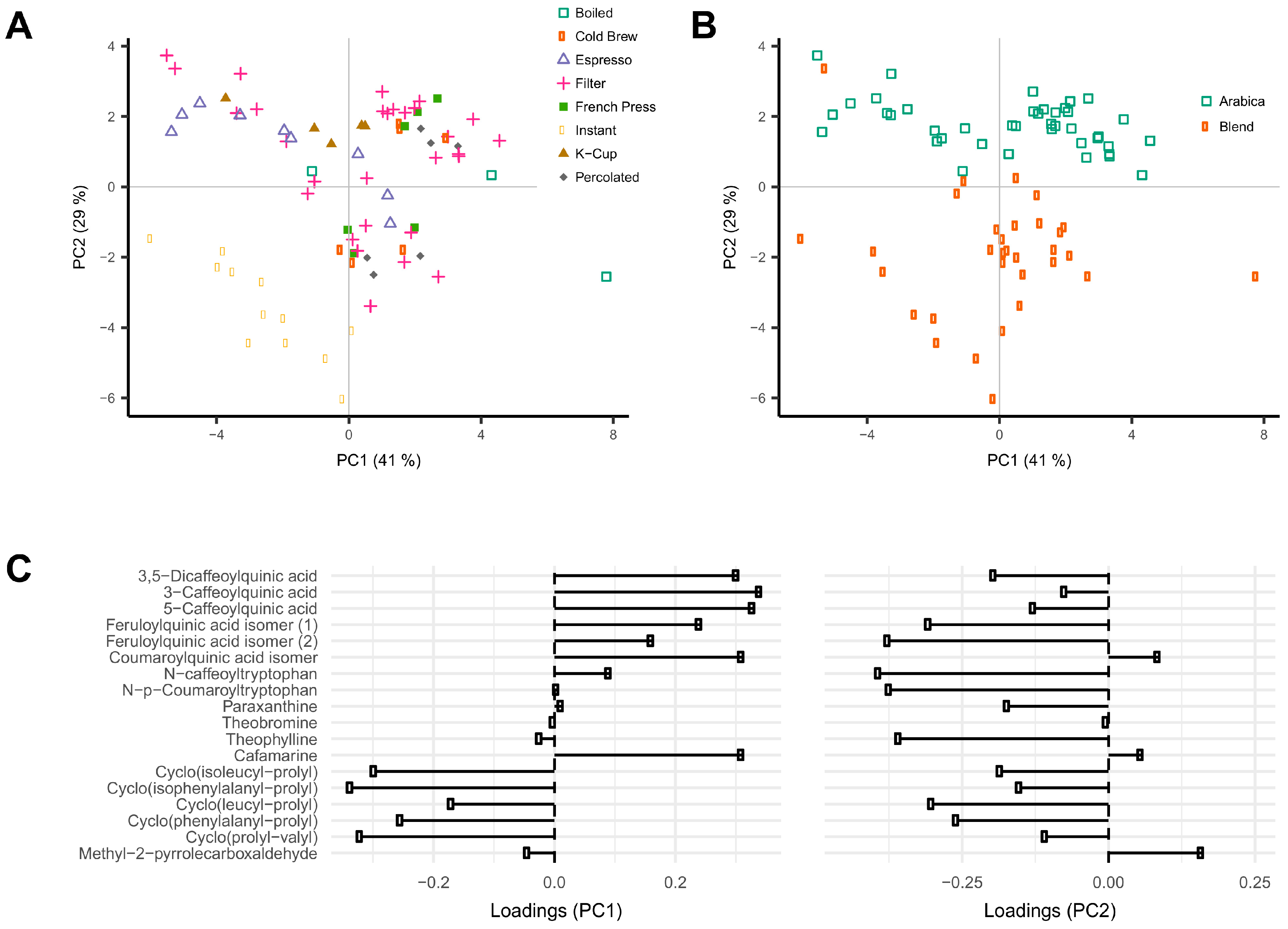
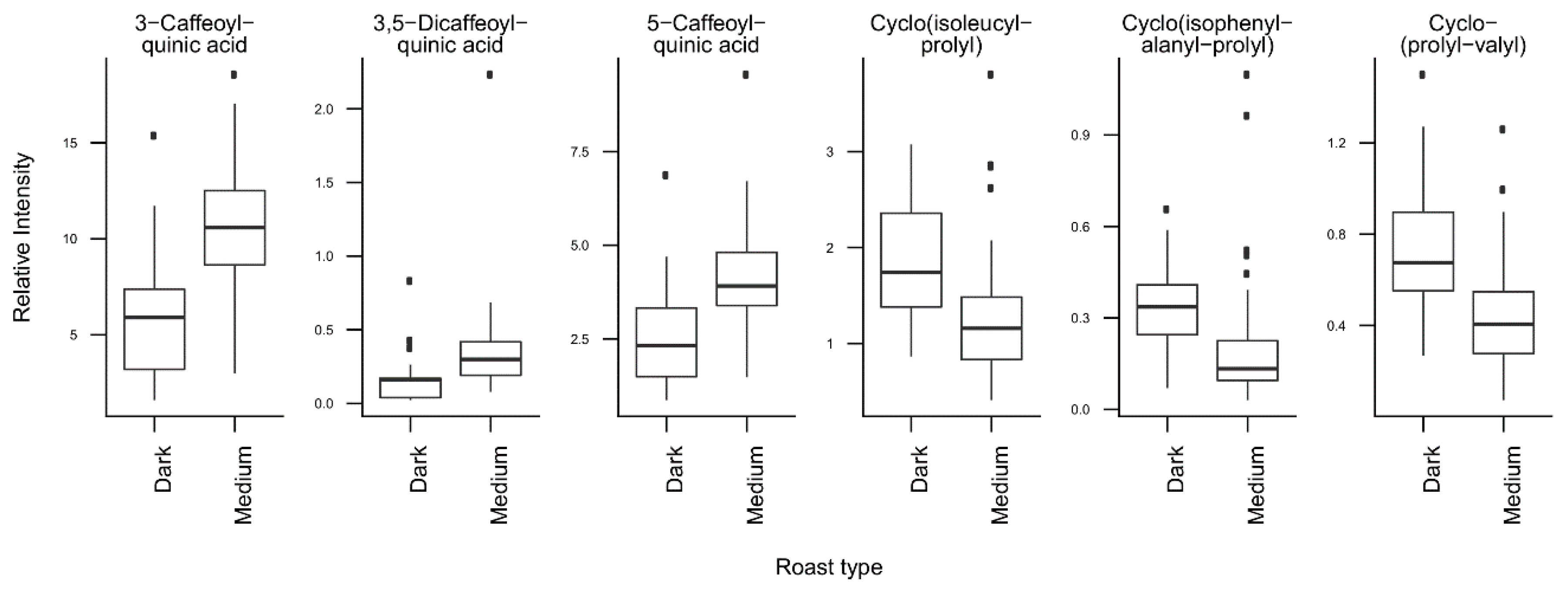
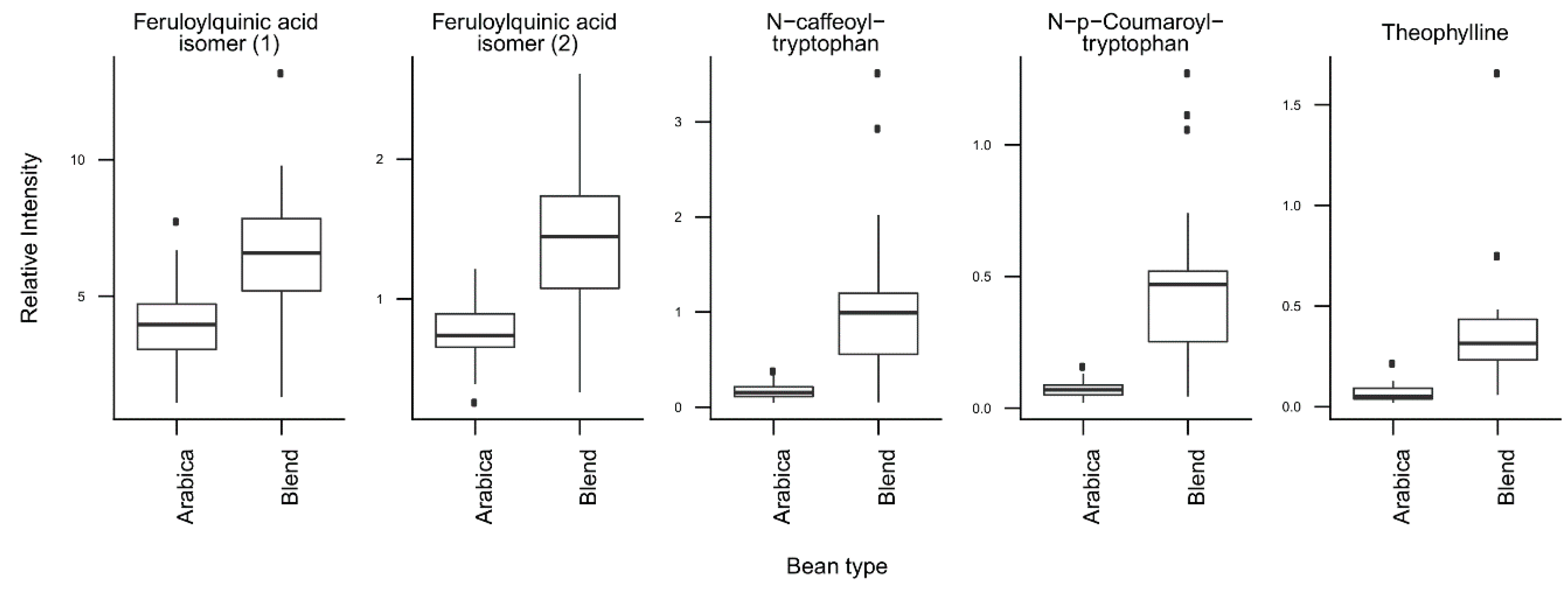
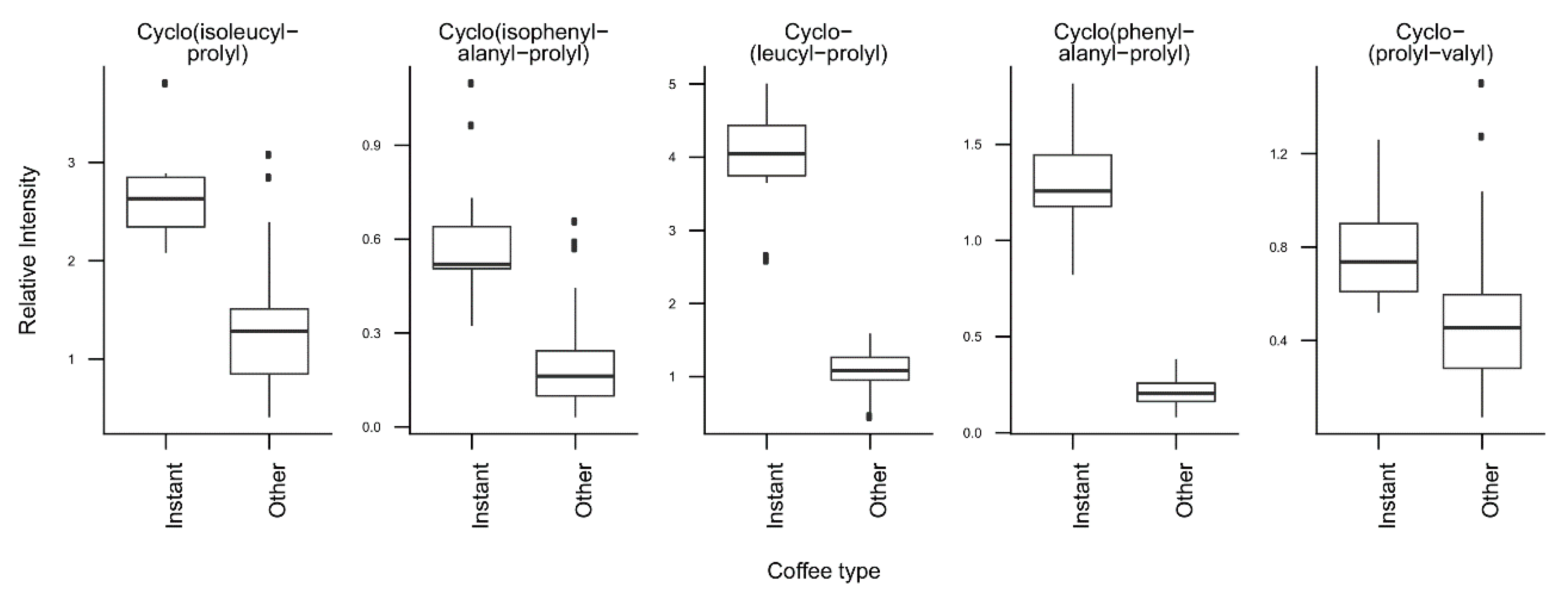
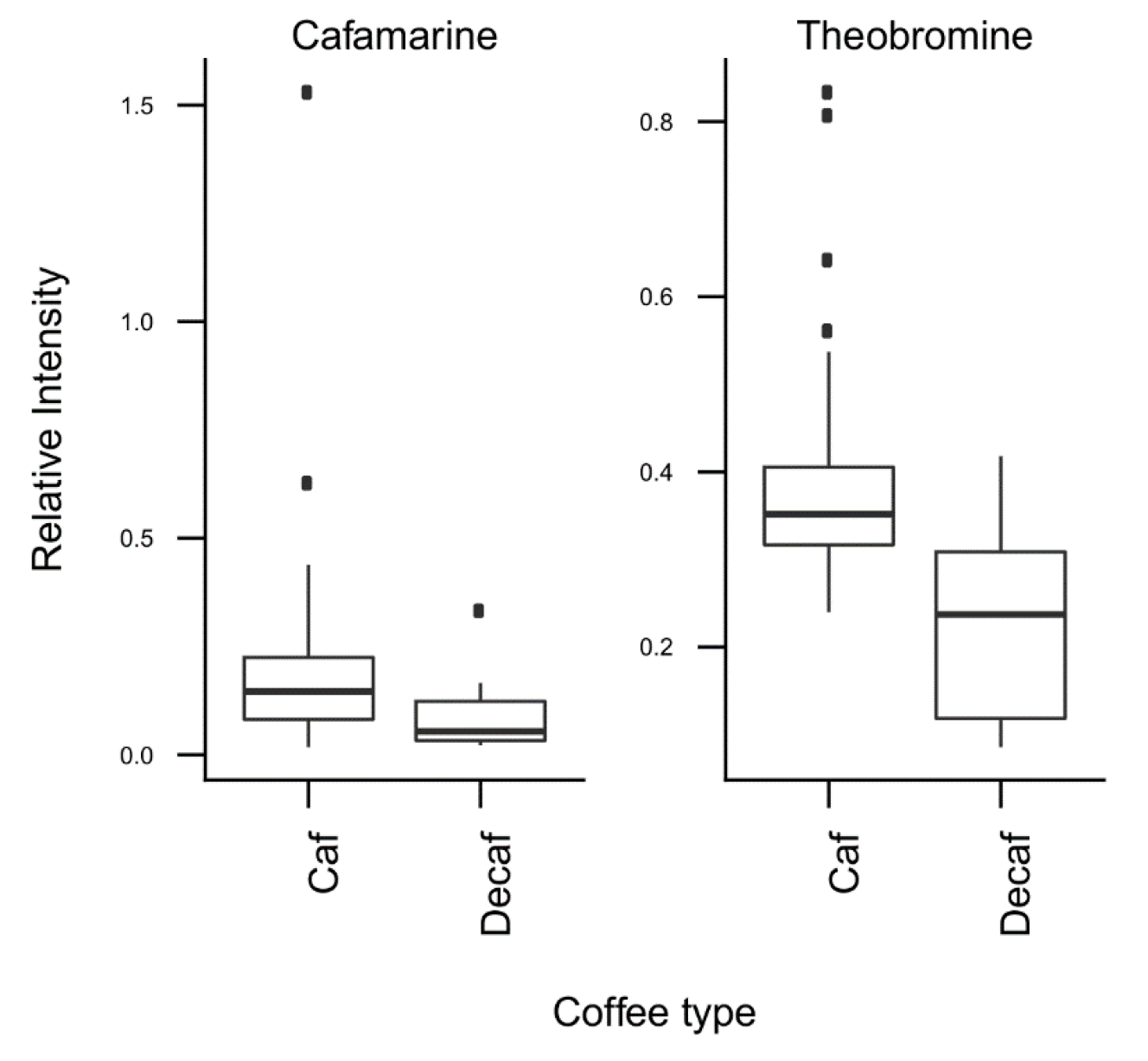
| Compound | Class | Formula | Observed m/z | Ion | Mass Difference (Delta ppm) | Retention Time (min) | Annotation Level 1 |
|---|---|---|---|---|---|---|---|
| 3,5-Dicaffeoylquinic acid | Phenolic acid ester | C25H24O12 | 517.1347 | [M + H]+ | 0.63 | 3.85 | 1 |
| 3-Caffeoylquinic acid | Phenolic acid ester | C16H18O9 | 355.1030 | [M + H]+ | 0.62 | 2.94 | 1 |
| 5-Caffeoylquinic acid | Phenolic acid ester | C16H18O9 | 355.1030 | [M + H]+ | 0.90 | 2.46 | 1 |
| Feruloylquinic acid isomer (i) | Phenolic acid ester | C17H20O9 | 369.1186 | [M + H]+ | 1.27 | 3.47 | 3 |
| Feruloylquinic acid isomer (ii) | Phenolic acid ester | C17H20O9 | 369.1186 | [M + H]+ | 1.27 | 2.99 | 3 |
| Coumaroylquinic acid isomer | Phenolic acid ester | C16H18O8 | 339.1081 | [M + H]+ | 1.97 | 3.35 | 3 |
| N-caffeoyltryptophan | Phenolic acid amide | C20H18N2O5 | 367.1295 | [M + H]+ | 1.99 | 4.48 | 2 |
| N-p-Coumaroyltryptophan | Phenolic acid amide | C20H18N2O4 | 351.1346 | [M + H]+ | 2.41 | 4.71 | 2 |
| Paraxanthine | Methylxanthine | C7H8N4O2 | 181.0726 | [M + H]+ | 10.41 | 2.69 | 1 |
| Theobromine | Methylxanthine | C7H8N4O2 | 181.0726 | [M + H]+ | 3.75 | 2.37 | 1 |
| Theophylline | Methylxanthine | C7H8N4O2 | 181.0726 | [M + H]+ | 4.30 | 2.81 | 1 |
| Cafamarine | Terpene glycoside | C26H36O10 | 509.2387 | [M + H]+ | 0.50 | 4.05 | 3 |
| Cyclo(isoleucyl-prolyl) | Diketopiperazine | C11H18N2O2 | 211.1447 | [M + H]+ | 3.67 | 3.76 | 2 |
| Cyclo(isophenylalanyl-prolyl) | Diketopiperazine | C14H16N2O2 | 245.1291 | [M + H]+ | 5.01 | 3.94 | 2 |
| Cyclo(leucyl-prolyl) | Diketopiperazine | C11H18N2O2 | 211.1447 | [M + H]+ | 3.67 | 3.87 | 1 |
| Cyclo(phenylalanyl-prolyl) | Diketopiperazine | C14H16N2O2 | 245.1291 | [M + H]+ | 3.78 | 4.05 | 1 |
| Cyclo(prolyl-valyl) | Diketopiperazine | C10H16N2O2 | 197.1291 | [M + H]+ | 3.17 | 3.08 | 1 |
| Methyl-2-pyrrolecarboxaldehyde | Heteroaromatic compound | C6H7NO | 110.0607 | [M + H]+ | 4.00 | 3.62 | 1 |
© 2019 by the authors. Licensee MDPI, Basel, Switzerland. This article is an open access article distributed under the terms and conditions of the Creative Commons Attribution (CC BY) license (http://creativecommons.org/licenses/by/4.0/).
Share and Cite
Rothwell, J.A.; Loftfield, E.; Wedekind, R.; Freedman, N.; Kambanis, C.; Scalbert, A.; Sinha, R. A Metabolomic Study of the Variability of the Chemical Composition of Commonly Consumed Coffee Brews. Metabolites 2019, 9, 17. https://doi.org/10.3390/metabo9010017
Rothwell JA, Loftfield E, Wedekind R, Freedman N, Kambanis C, Scalbert A, Sinha R. A Metabolomic Study of the Variability of the Chemical Composition of Commonly Consumed Coffee Brews. Metabolites. 2019; 9(1):17. https://doi.org/10.3390/metabo9010017
Chicago/Turabian StyleRothwell, Joseph A., Erikka Loftfield, Roland Wedekind, Neal Freedman, Callie Kambanis, Augustin Scalbert, and Rashmi Sinha. 2019. "A Metabolomic Study of the Variability of the Chemical Composition of Commonly Consumed Coffee Brews" Metabolites 9, no. 1: 17. https://doi.org/10.3390/metabo9010017
APA StyleRothwell, J. A., Loftfield, E., Wedekind, R., Freedman, N., Kambanis, C., Scalbert, A., & Sinha, R. (2019). A Metabolomic Study of the Variability of the Chemical Composition of Commonly Consumed Coffee Brews. Metabolites, 9(1), 17. https://doi.org/10.3390/metabo9010017






